Abstract
Down syndrome (DS) is a major cause of congenital heart and gut disease and mental retardation. DS individuals also have characteristic facies, hands, and dermatoglyphics, in addition to abnormalities of the immune system, an increased risk of leukemia, and an Alzheimer-like dementia. Although their molecular basis is unknown, recent work on patients with DS and partial duplications of chromosome 21 has suggested small chromosomal regions located in band q22 that are likely to contain the genes for some of these features. We now extend these analyses to define molecular markers for the congenital heart disease, the duodenal stenosis, and an "overlap" region for the facial and some of the skeletal features. We report the clinical, cytogenetic, and molecular analysis of two patients. The first is DUP21JS, who carries both a partial duplication of chromosome 21, including the region 21q21.1-q22.13, or proximal q22.2, and DS features including duodenal stenosis. Using quantitative Southern blot dosage analysis and 15 DNA sequences unique to chromosome 21, we have defined the molecular extent of the duplication. This includes the region defined by DNA sequences for APP (amyloid precursor protein), SOD1 (CuZn superoxide dismutase), D21S47, SF57, D21S17, D21S55, D21S3, and D21S15 and excludes the regions defined by DNA sequences for D21S16, D21S46, D21S1, D21S19, BCE I (breast cancer estrogen-inducible gene), D21S39, and D21S44. Using similar techniques, we have also defined the region duplicated in the second case occurring in a family carrying a translocation associated with DS and congenital heart disease. This region includes DNA sequences for D21S55 and D21S3 and excludes DNA sequences for D21S47 and D21S17.(ABSTRACT TRUNCATED AT 250 WORDS)
Full text
PDF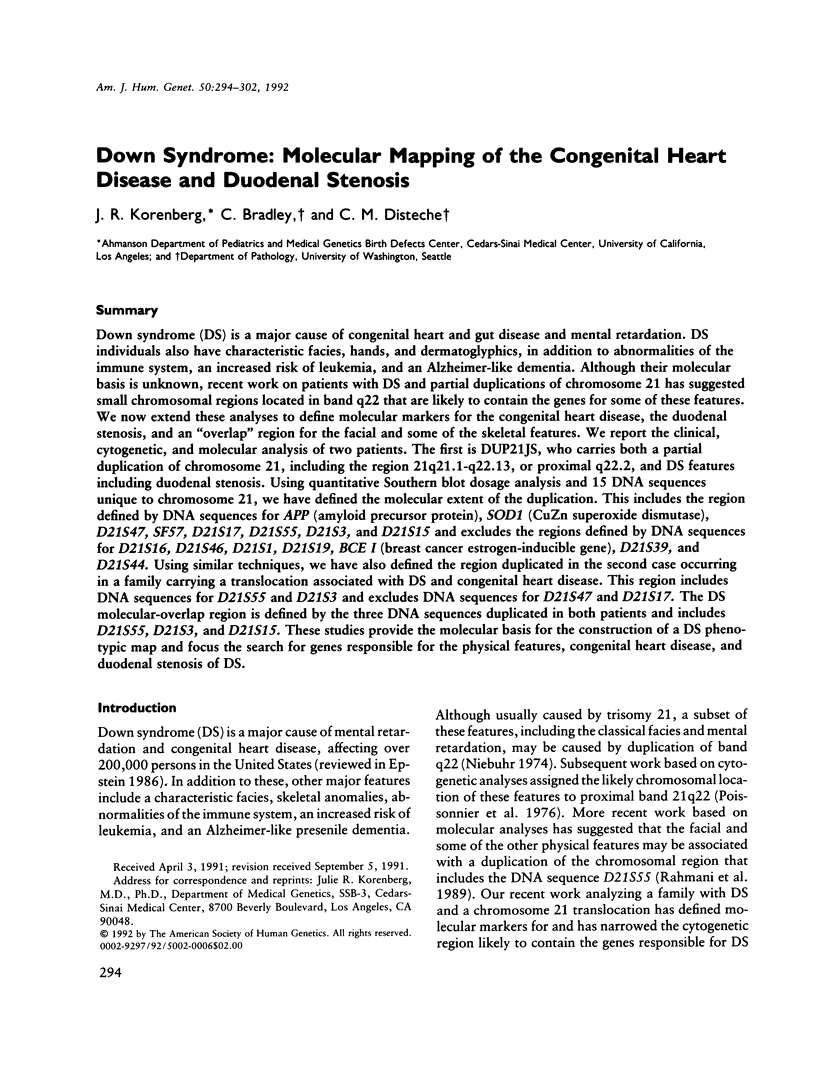
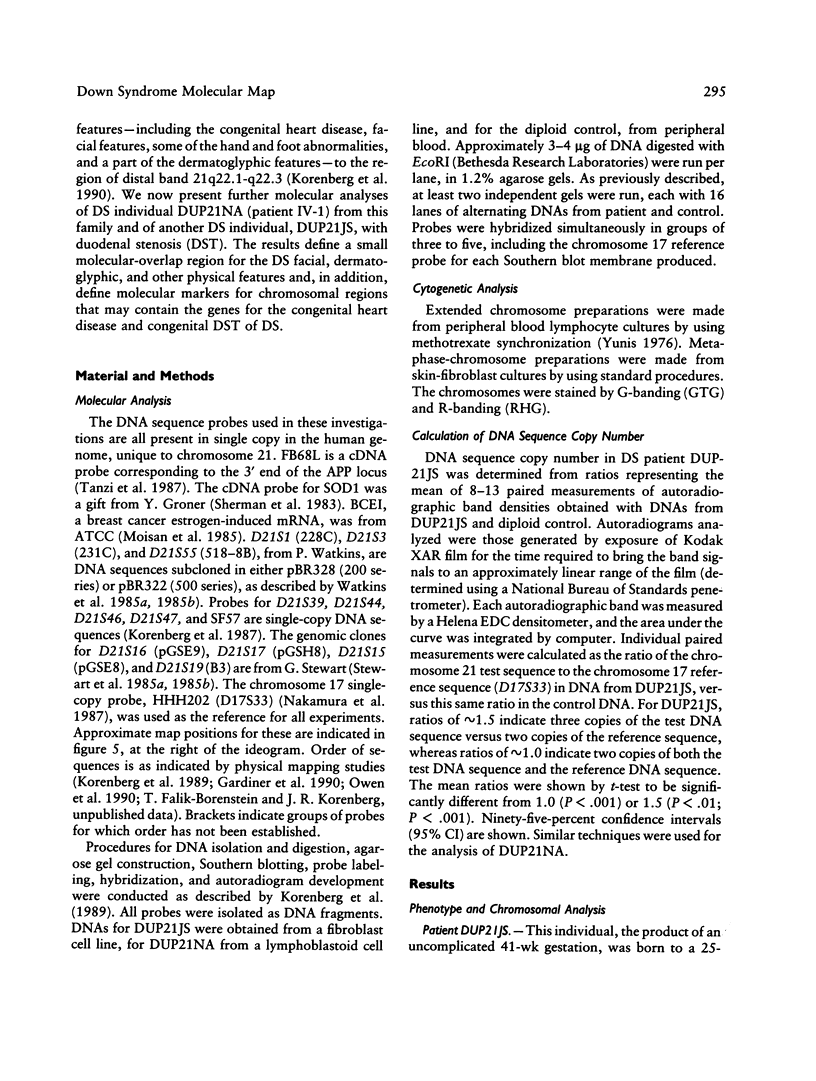

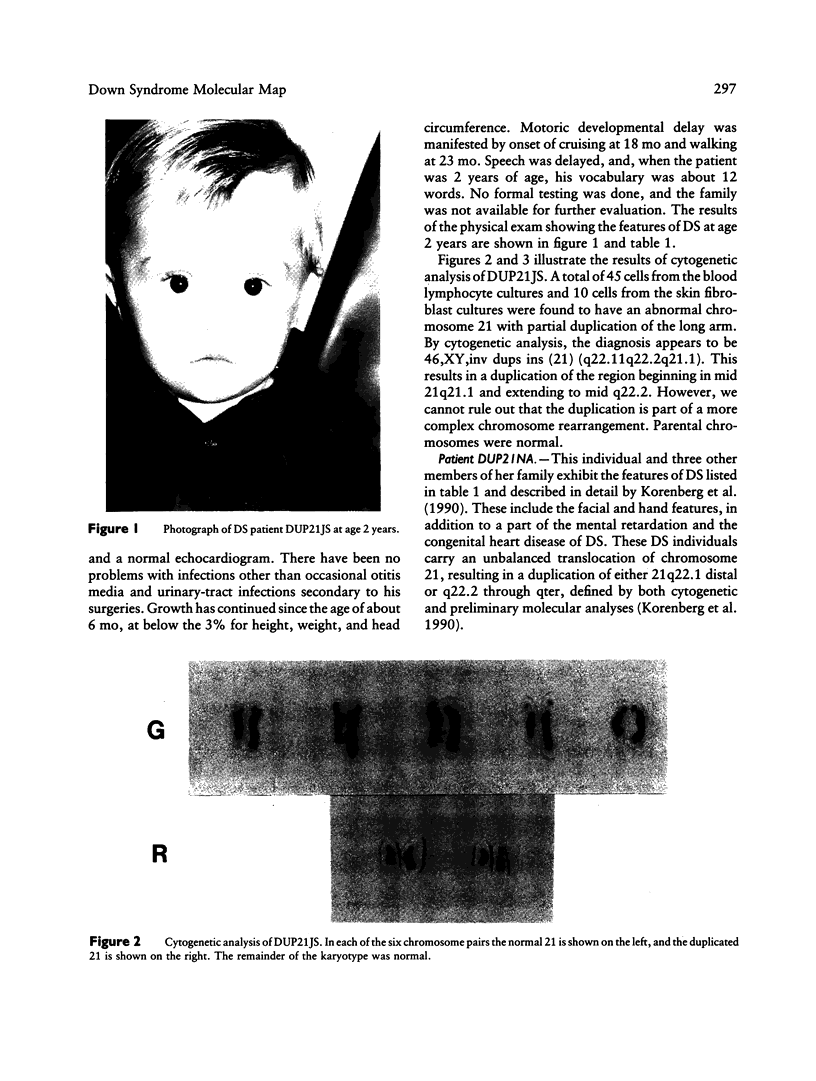

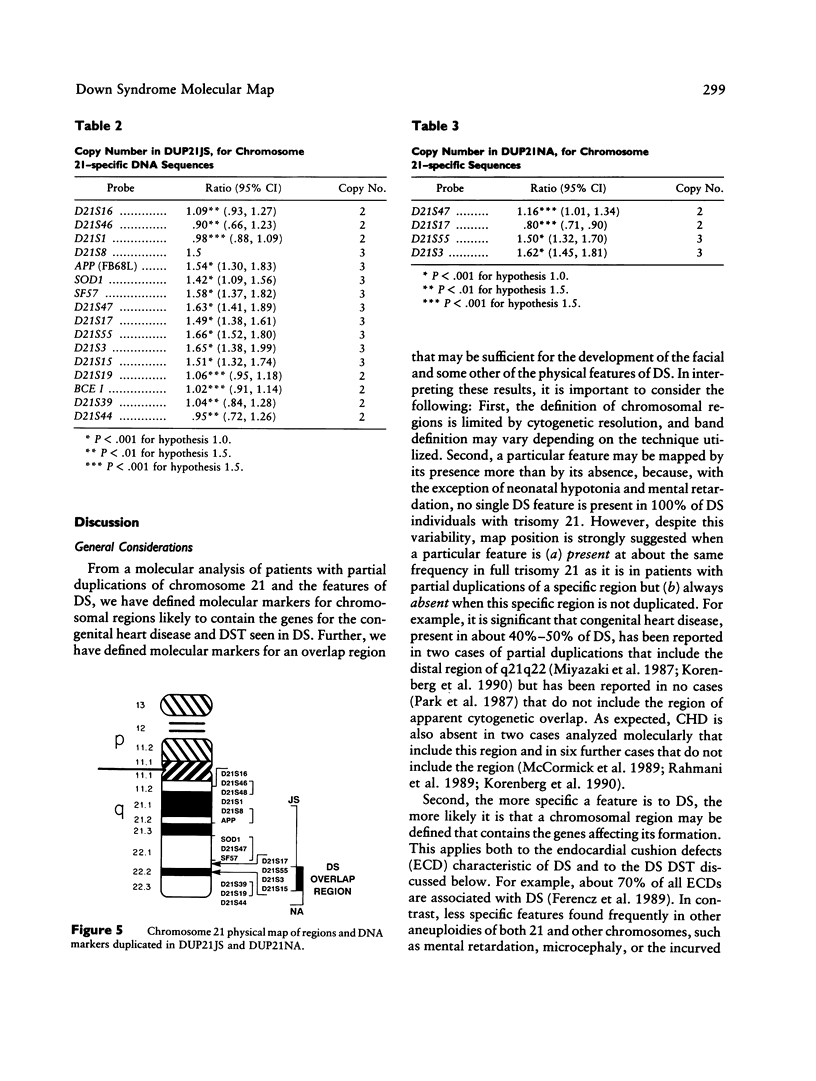
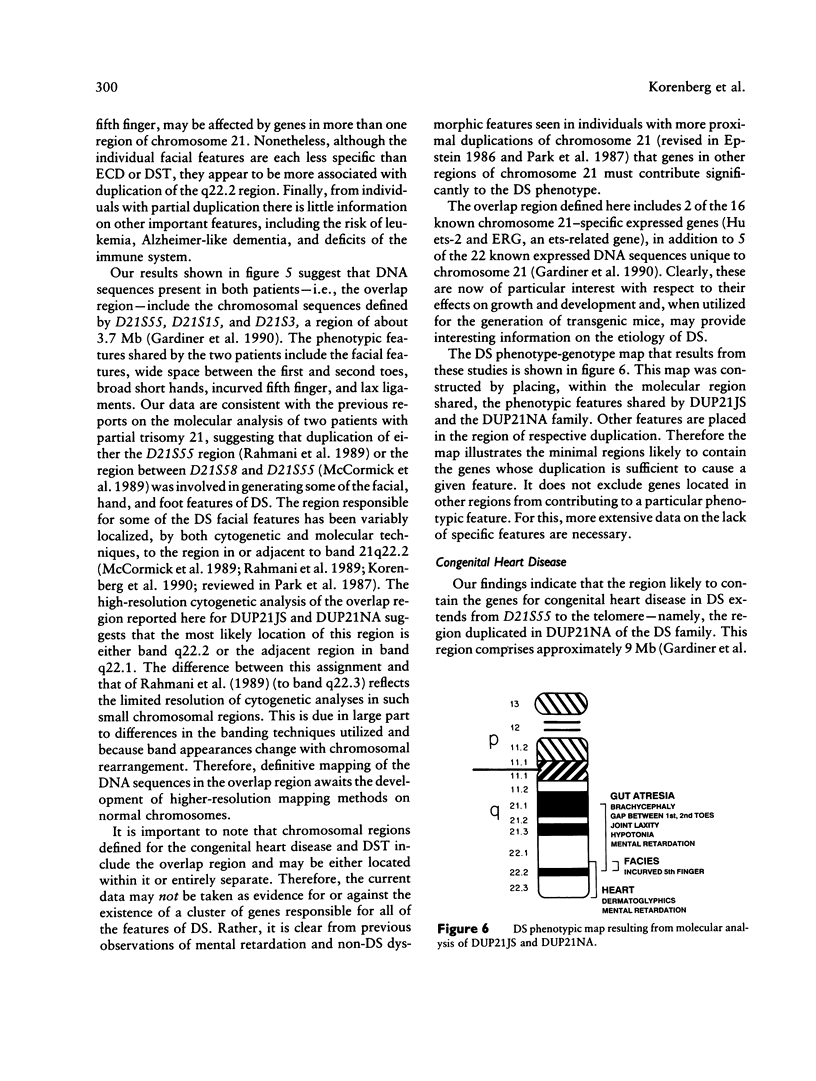


Images in this article
Selected References
These references are in PubMed. This may not be the complete list of references from this article.
- Cheng S. V., Nadeau J. H., Tanzi R. E., Watkins P. C., Jagadesh J., Taylor B. A., Haines J. L., Sacchi N., Gusella J. F. Comparative mapping of DNA markers from the familial Alzheimer disease and Down syndrome regions of human chromosome 21 to mouse chromosomes 16 and 17. Proc Natl Acad Sci U S A. 1988 Aug;85(16):6032–6036. doi: 10.1073/pnas.85.16.6032. [DOI] [PMC free article] [PubMed] [Google Scholar]
- Gardiner K., Horisberger M., Kraus J., Tantravahi U., Korenberg J., Rao V., Reddy S., Patterson D. Analysis of human chromosome 21: correlation of physical and cytogenetic maps; gene and CpG island distributions. EMBO J. 1990 Jan;9(1):25–34. doi: 10.1002/j.1460-2075.1990.tb08076.x. [DOI] [PMC free article] [PubMed] [Google Scholar]
- Korenberg J. R., Croyle M. L., Cox D. R. Isolation and regional mapping of DNA sequences unique to human chromosome 21. Am J Hum Genet. 1987 Dec;41(6):963–978. [PMC free article] [PubMed] [Google Scholar]
- Korenberg J. R., Kawashima H., Pulst S. M., Ikeuchi T., Ogasawara N., Yamamoto K., Schonberg S. A., West R., Allen L., Magenis E. Molecular definition of a region of chromosome 21 that causes features of the Down syndrome phenotype. Am J Hum Genet. 1990 Aug;47(2):236–246. [PMC free article] [PubMed] [Google Scholar]
- Korenberg J. R., Pulst S. M., Neve R. L., West R. The Alzheimer amyloid precursor protein maps to human chromosome 21 bands q21.105-q21.05. Genomics. 1989 Jul;5(1):124–127. doi: 10.1016/0888-7543(89)90095-5. [DOI] [PubMed] [Google Scholar]
- McCormick M. K., Schinzel A., Petersen M. B., Stetten G., Driscoll D. J., Cantu E. S., Tranebjaerg L., Mikkelsen M., Watkins P. C., Antonarakis S. E. Molecular genetic approach to the characterization of the "Down syndrome region" of chromosome 21. Genomics. 1989 Aug;5(2):325–331. doi: 10.1016/0888-7543(89)90065-7. [DOI] [PubMed] [Google Scholar]
- Miyabara S., Gropp A., Winking H. Trisomy 16 in the mouse fetus associated with generalized edema and cardiovascular and urinary tract anomalies. Teratology. 1982 Jun;25(3):369–380. doi: 10.1002/tera.1420250314. [DOI] [PubMed] [Google Scholar]
- Miyazaki K., Yamanaka T., Ogasawara N. A boy with Down's syndrome having recombinant chromosome 21 but no SOD-1 excess. Clin Genet. 1987 Dec;32(6):383–387. doi: 10.1111/j.1399-0004.1987.tb03154.x. [DOI] [PubMed] [Google Scholar]
- Nakamura Y., Leppert M., O'Connell P., Wolff R., Holm T., Culver M., Martin C., Fujimoto E., Hoff M., Kumlin E. Variable number of tandem repeat (VNTR) markers for human gene mapping. Science. 1987 Mar 27;235(4796):1616–1622. doi: 10.1126/science.3029872. [DOI] [PubMed] [Google Scholar]
- Niebuhr E. Down's syndrome. The possibility of a pathogenetic segment on chromosome no. 21. Humangenetik. 1974 Jan 22;21(1):99–101. doi: 10.1007/BF00278575. [DOI] [PubMed] [Google Scholar]
- Owen M. J., James L. A., Hardy J. A., Williamson R., Goate A. M. Physical mapping around the Alzheimer disease locus on the proximal long arm of chromosome 21. Am J Hum Genet. 1990 Feb;46(2):316–322. [PMC free article] [PubMed] [Google Scholar]
- Park J. P., Wurster-Hill D. H., Andrews P. A., Cooley W. C., Graham J. M., Jr Free proximal trisomy 21 without the Down syndrome. Clin Genet. 1987 Nov;32(5):342–348. doi: 10.1111/j.1399-0004.1987.tb03299.x. [DOI] [PubMed] [Google Scholar]
- Poissonnier M., Saint-Paul B., Dutrillaux B., Chassaigne M., Gruyer P., de Blignières-Strouk G. Trisomie 21 partielle (21q21 leads to 21q22.2) Ann Genet. 1976 Mar;19(1):69–73. [PubMed] [Google Scholar]
- Rahmani Z., Blouin J. L., Creau-Goldberg N., Watkins P. C., Mattei J. F., Poissonnier M., Prieur M., Chettouh Z., Nicole A., Aurias A. Critical role of the D21S55 region on chromosome 21 in the pathogenesis of Down syndrome. Proc Natl Acad Sci U S A. 1989 Aug;86(15):5958–5962. doi: 10.1073/pnas.86.15.5958. [DOI] [PMC free article] [PubMed] [Google Scholar]
- Reeves R. H., Crowley M. R., Lorenzon N., Pavan W. J., Smeyne R. J., Goldowitz D. The mouse neurological mutant weaver maps within the region of chromosome 16 that is homologous to human chromosome 21. Genomics. 1989 Oct;5(3):522–526. doi: 10.1016/0888-7543(89)90018-9. [DOI] [PubMed] [Google Scholar]
- Sherman L., Dafni N., Lieman-Hurwitz J., Groner Y. Nucleotide sequence and expression of human chromosome 21-encoded superoxide dismutase mRNA. Proc Natl Acad Sci U S A. 1983 Sep;80(18):5465–5469. doi: 10.1073/pnas.80.18.5465. [DOI] [PMC free article] [PubMed] [Google Scholar]
- Stewart G. D., Harris P., Galt J., Ferguson-Smith M. A. Cloned DNA probes regionally mapped to human chromosome 21 and their use in determining the origin of nondisjunction. Nucleic Acids Res. 1985 Jun 11;13(11):4125–4132. doi: 10.1093/nar/13.11.4125. [DOI] [PMC free article] [PubMed] [Google Scholar]
- Stewart G. D., Tanzi R. E., Gusella J. F. RFLPS at the D21S19 locus of human chromosome 21. Nucleic Acids Res. 1985 Oct 11;13(19):7168–7168. doi: 10.1093/nar/13.19.7168. [DOI] [PMC free article] [PubMed] [Google Scholar]
- Tanzi R. E., Gusella J. F., Watkins P. C., Bruns G. A., St George-Hyslop P., Van Keuren M. L., Patterson D., Pagan S., Kurnit D. M., Neve R. L. Amyloid beta protein gene: cDNA, mRNA distribution, and genetic linkage near the Alzheimer locus. Science. 1987 Feb 20;235(4791):880–884. doi: 10.1126/science.2949367. [DOI] [PubMed] [Google Scholar]
- Watkins P. C., Tanzi R. E., Gibbons K. T., Tricoli J. V., Landes G., Eddy R., Shows T. B., Gusella J. F. Isolation of polymorphic DNA segments from human chromosome 21. Nucleic Acids Res. 1985 Sep 11;13(17):6075–6088. doi: 10.1093/nar/13.17.6075. [DOI] [PMC free article] [PubMed] [Google Scholar]
- Yunis J. J. High resolution of human chromosomes. Science. 1976 Mar 26;191(4233):1268–1270. doi: 10.1126/science.1257746. [DOI] [PubMed] [Google Scholar]





